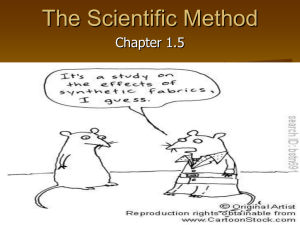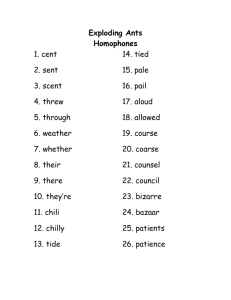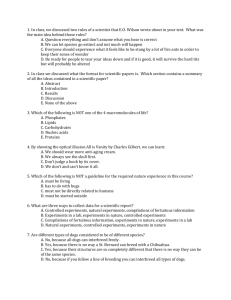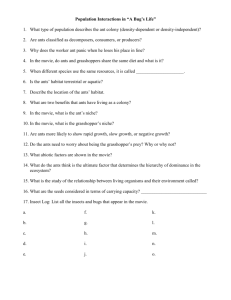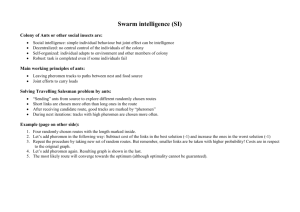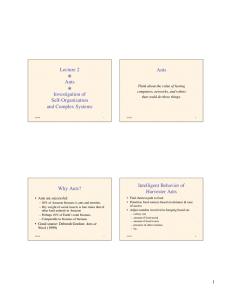Lecture 2 Z Ants Investigation of
advertisement
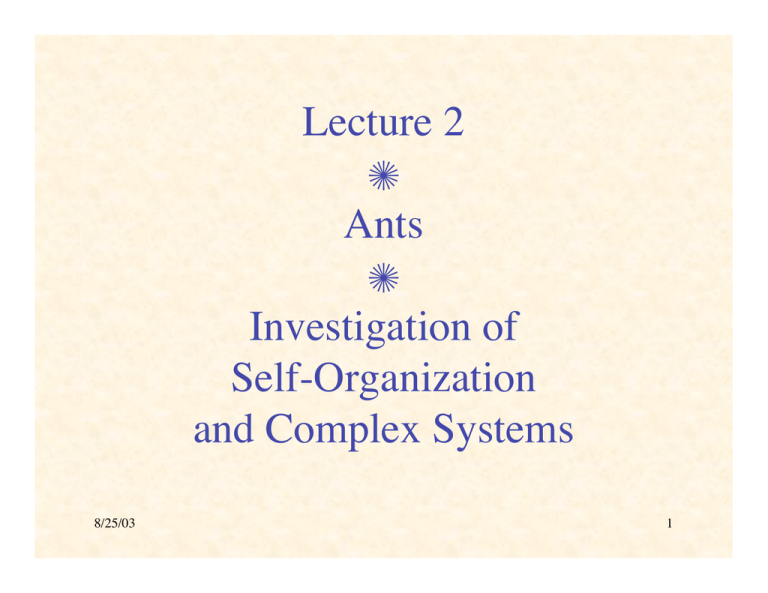
Lecture 2 Z Ants Z Investigation of Self-Organization and Complex Systems 8/25/03 1 CBN Text Website • Visit Flake CBN textbook website for errata, software, etc.: http://mitpress.mit.edu/books/FLAOH/cbnhtml 8/25/03 2 Ants Think about the value of having computers, networks, and robots that could do these things. 8/25/03 3 Why Ants? • Ants are successful: – 30% of Amazon biomass is ants and termites – Dry weight of social insects is four times that of other land animals in Amazon – Perhaps 10% of Earth’s total biomass – Comparable to biomass of humans • Good source: Deborah Gordon: Ants at Work (1999) 8/25/03 4 Intelligent Behavior of Harvester Ants • Find shortest path to food • Prioritize food sources based on distance & ease of access • Adjust number involved in foraging based on: – – – – – 8/25/03 colony size amount of food stored amount of food in area presence of other colonies etc. 5 Army Ants • No permanent nest • Create temporary “bivouacs” from bodies of workers • Raiding parties of up to 200 000 • Act like unified entity 8/25/03 6 Army Ant Raiding Patterns 8/25/03 from Solé & Goodwin, Signs of Life 7 Weaver Ants • • • • Form chains of bodies to bridge gaps Others may cross these bridges Use chains to pull leaf edges together Connect edges with silk from larvae held by workers 8/25/03 8 Adults Using Larvae as “Glue Guns” 8/25/03 9 Fungus Cultivator Ants • • • • • “Cultivate” fungi underground Construct “gardens” Plant spores Weed out competing fungi Fertilize with compost from chewed leaves 8/25/03 10 Maeterlinck on Ants “What is it that governs here? What is it that issues orders, foresees the future, elaborates plans, and preserves equilibrium?” 8/25/03 11 Emergent Aspects • Colony size ~ 8¥106 but no one is “in charge”! • Colony lifetime ~ 15 years • Colonies have a “life cycle” – older behave differently from younger • But ants live no longer than one year – Males live one day! 8/25/03 12 How do they do it? • Semiochemically: deposit pheromones – 10-20 signs, many signal tasks – ants detect pheromone gradients and frequency of encounter • Follow trails imperfectly fi exploration • Feedback reinforces successful trails fi biased randomness 8/25/03 13 8/25/03 slides from EVALife 14 8/25/03 slides from EVALife 15 8/25/03 slides from EVALife 16 8/25/03 slides from EVALife 17 8/25/03 slides from EVALife 18 8/25/03 slides from EVALife 19 Adaptive Path Optimization 8/25/03 slides from iridia.ulb.ac.be/~mdorigo 20 Adaptive Path Optimization 8/25/03 slides from iridia.ulb.ac.be/~mdorigo 21 Adaptive Path Optimization 8/25/03 slides from iridia.ulb.ac.be/~mdorigo 22 Adaptive Path Optimization 8/25/03 slides from iridia.ulb.ac.be/~mdorigo 23 Circular Causality • Global pattern emergent from total system • Individuals respond to local field 8/25/03 fig. from Solé & Godwin 24 Stigmergy • From stigmo/j = pricking + e1rgon = work • The project (work) in the environment is an instigation • Agent interactions may be: – direct – indirect (time-delayed through environment) • Mediates individual and colony levels 8/25/03 25 8/25/03 Fig, from EVALife 26 8/25/03 Fig, from EVALife 27 8/25/03 Fig. from EVALife 28 Advantages of Stigmergy • Permits simpler agents • Decreases direct communication between agents • Incremental improvement • Flexible, since when environment changes, agents respond appropriately 8/25/03 29 Some Principles Underlying Emergent Systems • • • • • “More is different” “Ignorance is useful” “Encourage random encounters” “Look for patterns in signals” “Pay attention to your neighbor” (“Local information leads to global wisdom”) — Johnson, Emergence, pp. 77-9. 8/25/03 30 Similar Principles of SO • Ant colonies • Development of embryo • Molecular interactions within cell • Neural networks 8/25/03 31 Comparison of Ant Colonies and Neural Networks Ant Colonies No. of units high Robustness high Connectivity local Memory short-term Connect. stability weak Global patterns trails Complex dynamics observed 8/25/03 Neural Nets high high local short/long term high brain waves common from Solé & Goodwin: Signs of Life, p. 149 32 Self-Organization • Concept originated in physics and chemistry – emergence of macroscopic patterns – out of microscopic processes & interactions • “Self-organization is a set of dynamical mechanisms whereby structures appear at the global level of a system from interactions among its lower-level components.” — Bonabeau, Dorigo & Theraulaz, p. 9 8/25/03 33 Four Ingredients of Self-Organization • Activity amplification by positive feedback • Activity balancing by negative feedback • Amplification of random fluctuations • Multiple Interactions — Bonabeau, Dorigo & Theraulaz, pp. 9-11 8/25/03 34 Characteristics of Self-Organized System • Creation of spatiotemporal structures in initially homogeneous medium • Multistability • Bifurcations when parameters are varied 8/25/03 — Bonabeau, Dorigo & Theraulaz, Swarm Intelligence, pp. 12-14 35

